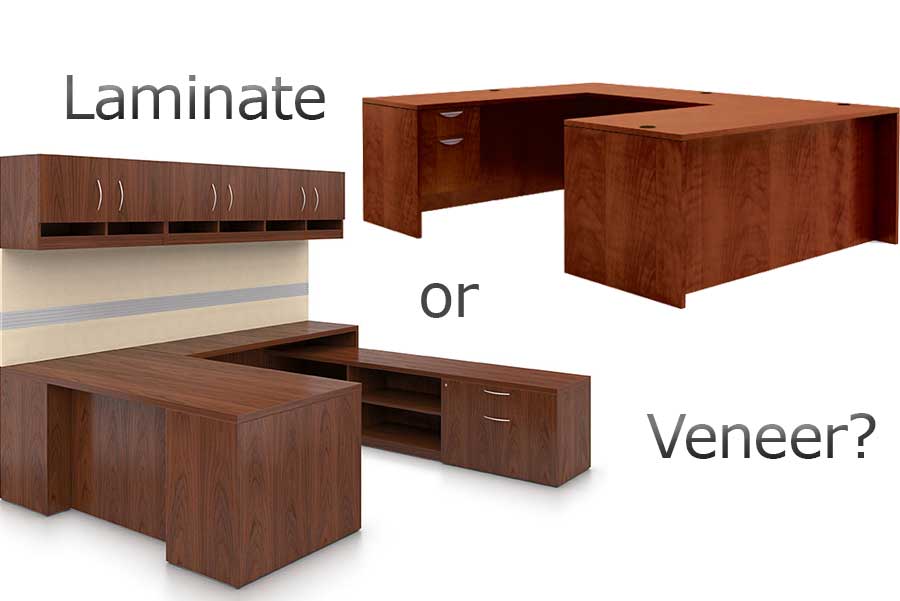
Choosing the right material for office furniture has a huge impact on the appearance, durability, and maintenance of your workspace.
Two very popular options for office furniture coverings are veneer and laminate. But which one is best for your office? Veneer or laminate office furniture?
Laminate furniture is better for durability, affordability, and ease of maintenance, ideal for busy offices. Veneer offers a more natural, premium wood look but is costlier and less resistant to wear. Choose laminate for practicality, veneer for aesthetics.
If you’re looking for the natural look of wood, are on a tight budget, or want long-lasting durability, understanding the differences and features of these two materials will help you make a better choice.
As you review your new office furniture options, you’ll find that both laminate and veneer offer many similar designs (casual, contemporary, or sophisticated) to give your office its own unique style.
Let’s discuss each type of finish to help you better decide what is best for you and your business.
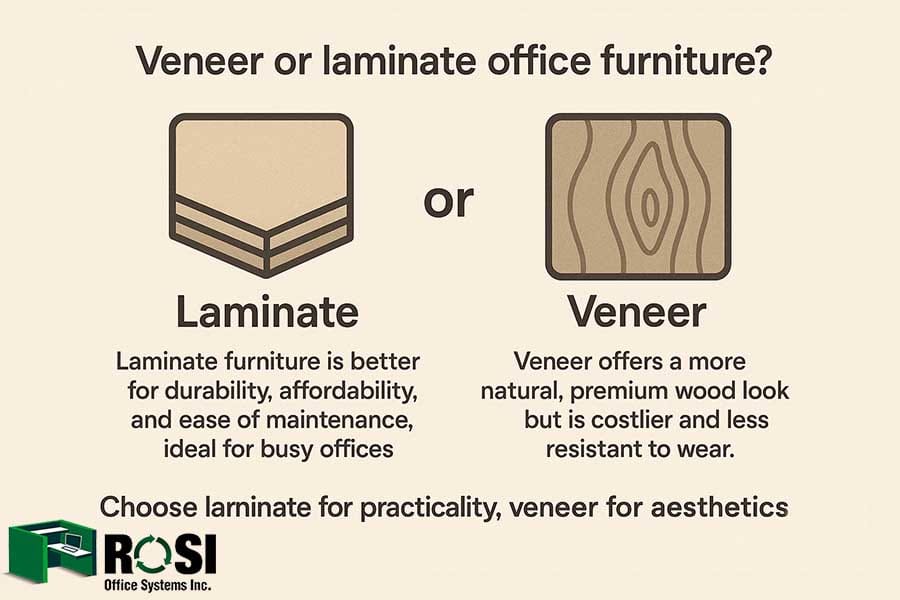
You Might Also Enjoy: Top 10 Brands for Soundproof Modular Office Cubicles [2025]
Laminate Office Furniture
Laminate office furniture is known for its durability, reliability, and affordability. Laminate is a synthetic material made of multiple layers.
These layers usually consist of paper and plastic resins that are pressed together under high pressure and heat.
One of the layers is a printed design that looks like natural wood or any other type of design.
The desktop is also treated with a clear coating, which resists scratches, stains, and condensation, making laminate ideal for high-traffic areas. The look is simple…there are no carved edges or detailing, which usually translates into savings. You can also find laminate desks in a variety of colors and patterns.
In fact, laminate is designed to imitate wood or other materials, and as such, it can have a uniform and precise appearance that, depending on the type of printing, can even look like natural wood.
As we said, laminate is very durable and more resistant to scratches, moisture, and stains than veneer, because its surface is completely plastic and non-porous.
Also, because it is a completely industrial and synthetic material, it usually costs less than veneer and is easier to maintain.
Laminate office furniture is perfect for high-use areas, hospitals, classrooms, and small to medium-sized businesses.
Veneer Office Furniture
Veneer is made with thin, decorative slices of wood affixed to a durable substrate material that resists warping.
These wood slices are usually only a few millimeters thick, making them less expensive to produce than using a single piece of wood, but they retain the completely natural and authentic appearance of the wood.
The underlying surface to which the veneer is attached is usually made of a cheaper, more durable material that provides strength and stability, such as MDF or plywood, as using a single thick piece of wood for the entire piece would be expensive and heavy.
Because veneer is made from real wood, it has the unique design and patterns of wood and gives the furniture a sense of luxury and high quality.
Veneer surfaces are stained in a multi-step process that produces a warm, rich finish mimicking the look of real hardwood.
Veneer office furniture is typically of a higher quality and is better constructed than laminate. The natural material is beautiful but can be softer and scratch easily.
A writing pad or desk blotter is recommended when using an office desk constructed of Veneer.
Wood veneer office furniture is often found in upscale executive offices in high-powered companies, conference rooms, reception desks, and even home offices.
1. Aesthetic Appeal
- Veneer: Because veneer is made from real wood, its appearance is completely natural and authentic.
Each piece of wood has its own unique grain patterns and coloration, shaped by nature, so no two pieces of veneer are exactly alike.
This feature makes veneer furniture feel warm, luxurious, and special.
For this reason, many management offices and formal spaces that seek to instill a sense of quality and prestige use veneer.
- Laminate: Laminate has a uniform appearance because its design is printed and industrial.
This feature ensures that all pieces are exactly the same shape and match.
Laminate can be produced in wood designs, stone designs, plain colors, or even modern designs, and is available in a wide range of colors and textures.
This variety makes it an ideal choice for creative, modern, or office spaces that require perfect coordination between furniture.
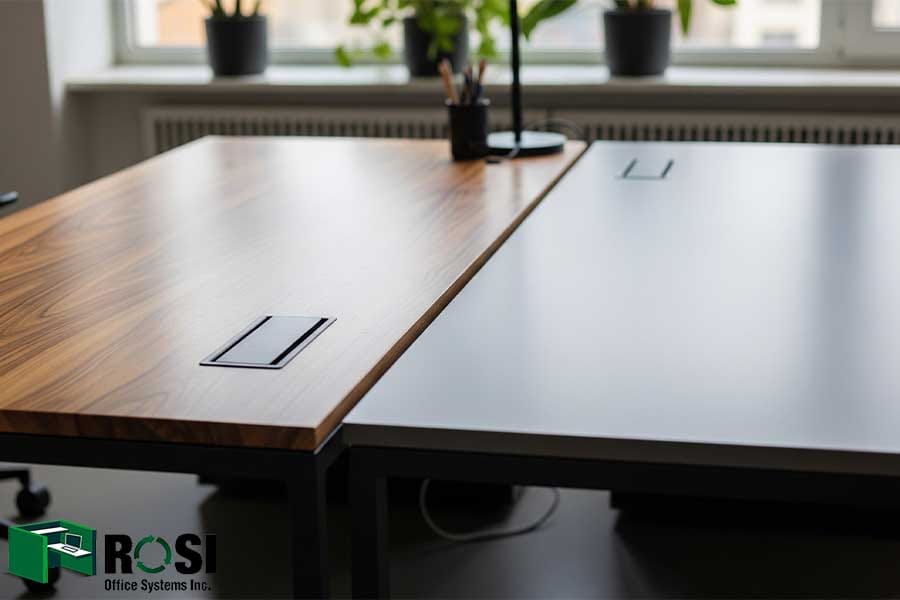
You Might Also Enjoy: Top 10 Key Features to Look for in Office Cubicles
2. Durability and Maintenance
- Veneer: Because veneer is made from a thin layer of natural wood, its surface is softer and more sensitive to scratches, impacts, and abrasions.
It also has little resistance to moisture and extreme temperature changes; if water or liquid remains on it for a long time, its surface may swell or stain.
Over time and with continued use, the veneer surface may become dull or scratched, requiring sanding and refinishing to restore its original beauty.
Of course, it has the advantage that it can be repaired multiple times, which is not possible with laminate.
- Laminate: Laminate is highly resistant to scratches, stains, and moisture due to its synthetic structure and plastic surface.
This feature makes it an ideal choice for high-traffic environments.
It’s also very easy to clean; usually, just a damp cloth or mild cleaning solution will make the surface look like new.
The only downside is that if the laminate surface is deeply damaged, it is difficult or impossible to repair, and usually the entire piece must be replaced.
3. Cost Considerations
- Veneer: Veneer is usually more expensive than laminate due to the use of natural wood as well as the manufacturing process that involves precise cutting and gluing of layers to a substrate.
In addition to the cost of raw materials, the execution of the work also requires more skill, which can increase the final price.
On the other hand, veneer furniture is often categorized as a luxury and high-quality product, so purchasing it is considered a long-term investment in the beauty and prestige of the office.
- Laminate: Laminate is much more affordable than veneer due to its synthetic nature and the use of cheaper materials in the manufacturing process.
Its construction and installation costs are lower, making it an economical option for businesses that want to create a neat and modern look on a smaller budget.
Laminate also has low maintenance costs due to its high durability, which saves money in the long run.
4. Environmental Impact
- Veneer: Veneer is made from real wood, which itself is a natural and renewable resource.
If the wood used is sourced from sustainable and managed sources, such as forests that are controlled logging and replanted, the use of veneer can be environmentally friendly.
Also, because veneer is only a thin layer of wood, it uses less wood than using thick, bulky wood, and therefore can be a less expensive and more resource-efficient option.
However, if wood is cut without supervision and from unauthorized sources, it can lead to deforestation and serious environmental damage.
- Laminate: Laminate is a synthetic product made from a combination of layers of paper, plastic resins, and chemicals.
Its production process is usually energy-intensive and involves the use of chemicals, which can have a negative impact on the environment.
Additionally, laminate is difficult to recycle after its useful life, as it is a combination of different materials that are difficult to separate.
However, some manufacturers are trying to use more environmentally friendly resins and formulated materials and optimize production processes to reduce emissions.
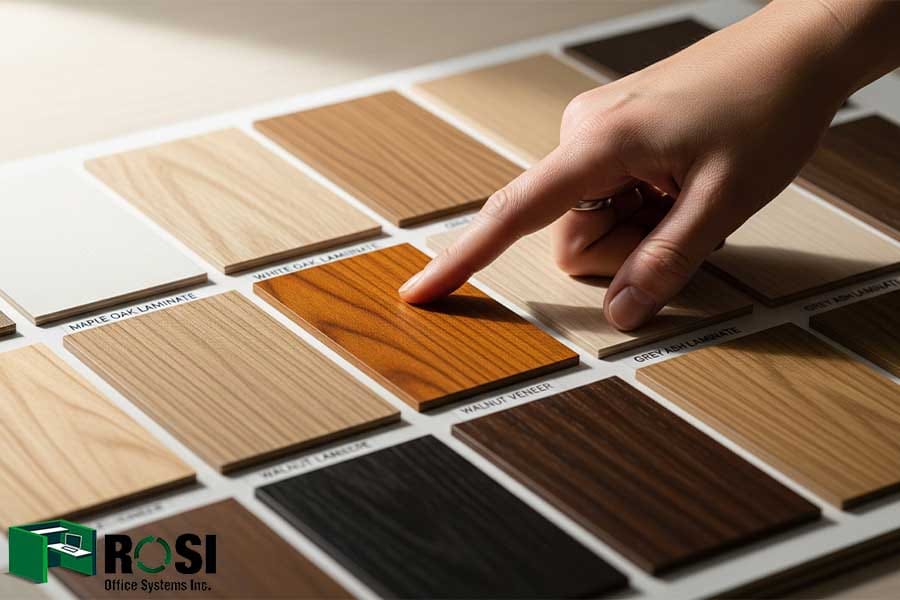
You Might Also Enjoy: What Are Office Cubicles Made of in 2025?
5. Suitability for Different Office Environments
- Veneer: Because of its natural and stylish appearance, veneer is an ideal choice for executive offices, conference rooms, and spaces where beauty and prestige are of great importance.
In these spaces, the luxurious look and high-quality feel of real wood can have a positive impact on audiences and employees and make the work environment appear more professional.
However, due to the veneer’s greater sensitivity to scratches and moisture, it is not recommended for use in high-traffic environments or locations where there is a high risk of damage.
- Laminate: Due to its high durability, resistance to scratches, stains, and moisture, laminate is a good option for high-traffic environments, offices with high traffic, and spaces that require easy and quick maintenance.
This material is very suitable for employee areas, waiting areas, public offices, and even schools or educational centers.
Due to its easy-to-clean nature, laminate is more practical in environments where there is more dirt or stains and can minimize maintenance costs.
6. Texture
- Veneer: Because veneer is made from thin layers of real wood, its surface usually has the natural texture of wood.
This means that when you run your hand over the surface, you may feel the subtle irregularities, veins, and natural ridges of the wood.
These irregularities are very subtle and pleasant, and they convey a sense of warmth and naturalness to the skin.
- Laminate: Unlike veneer, there is usually no natural texture or roughness on the surface of laminate, and it is completely smooth and uniform.
This smooth surface makes you feel like you are touching a plastic or glass surface when you touch it, which may seem a little cold or artificial.
Of course, some specially designed laminates may be slightly textured, but again, this texture is artificial and cannot convey the natural feel of real wood.
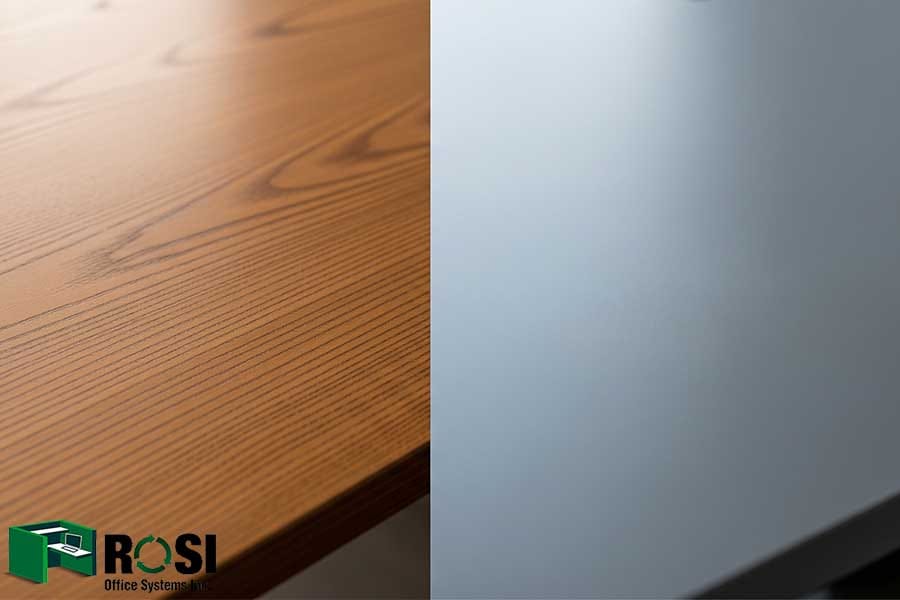
Conclusion
When choosing between veneer and laminate office furniture, it is important to pay attention to the key differences and considerations.
In this article, we talked about veneer vs. laminate office furniture in detail to help you choose the best one.
Veneer, with its natural, authentic wood appearance and unique veins, is an ideal choice for executive offices and spaces where beauty and prestige are a priority.
But this type of furniture requires more care, is more sensitive to scratches and moisture, and usually costs more.
In contrast, laminate offers a durable, uniform surface that is highly resistant to scratches, stains, and moisture, making it a cost-effective and practical option for high-traffic spaces and easy-to-maintain environments.
Finally, the choice between veneer or laminate office furniture should be based on the specific needs of your office, considering budget, durability, aesthetic taste, and environmental considerations.
By understanding these differences, you can choose the best material to suit your design goals and desired performance to create a beautiful and functional work environment.
Hopefully, this post has helped guide you on which direction you should take to outfit your office space.
No matter your preference, it is extremely important to do your homework beforehand.
Still unsure of which one is right for your business and where to buy office furniture?
Visit rosiinc.com and request a free consultation.
Our qualified workplace designers are ready to talk to you about your next office furniture project.

John Ofield is a recognized expert in the office furniture and office cubicle industry in Houston, TX, with over 40 years of experience. As the founder of ROSI Office Systems, he specializes in furniture space planning, custom cubicle designs, modern office chairs and tables, and high-quality commercial furniture. John’s expertise helps businesses enhance productivity and collaboration. He is also dedicated to mentoring entrepreneurs and redefining workspaces to inspire success.